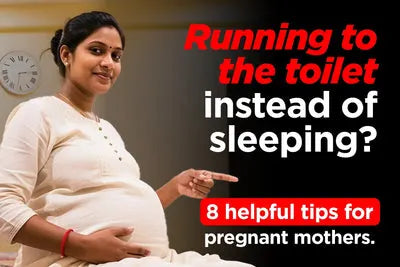There are different types of urinary incontinence that you could be suffering from. Understanding your condition can help you treat and deal with your condition better. In this blog, we are helping you identify the difference between stress incontinence and an overactive bladder.
Overactive bladder (OAB) is a condition in which a person can’t always control when their bladder muscles move, causing them to feel sudden, frequent, and strong urge to urinate throughout the day.
On the other hand, stress incontinence is a condition in which a person can’t prevent urine from leakage when pressure is applied on their abdomen or bladder.
Although OAB and stress incontinence are both conditions that revolve around urination and even some – they are not the same. But their symptoms overlap, treatments overlap, and even causes overlap. Continue reading to learn all about stress incontinence vs overactive bladder, how they differ, and treatment options that are available.

What exactly is an overactive bladder?
Overactive bladder occurs when a muscle in the bladder known as the detrusor contracts more often than normal. This causes a person to feel a sudden and strong urge to urinate, even when the bladder isn’t exactly full.
Typically, as the bladder reaches its capacity, it sends a signal through the nerves to the brain to let you know that you have to relieve yourself. As a result, you are able to make it to the toilet in time and your brain starts the process of urination. With OAB, the signaling process malfunctions, resulting in the bladder sending only strong and urgent signals instead of sending signals of varying intensity. Due to these strong signals, the ability to hold in urine is also weakened, and the detrusor spasms and releases urine involuntarily.
Common symptoms of an overactive bladder
But just the urge to urinate often does not automatically mean you’re dealing with OAB as it can also mean some other urinary condition. Instead, there are a collection of symptoms that can help you determine the condition:
-
Urinating more than 8 times in a period of 24 hours.
-
Feeling sudden and strong urges with little to no chance to postpone urination.
-
Experiencing wetting accidents or urine leakage after the sudden and strong urge to urinate.
What causes an overactive bladder?
While OAB is a condition common in both men and women, it’s most found in women. This is due to the changes in hormone levels and weakening of pelvic floor muscles – the muscles that span the bottom of the pelvis and support the pelvic organs. This weakening of the muscles happens after experiencing pregnancy, childbirth and menopause.
Other common causes of an overactive bladder include:
-
Obesity
-
Ageing
-
Poor nutrition
-
vCondition that can affect the nerves such as Parkinson’s disease, stroke, multiple sclerosis
-
Family history of OAB
-
Urinary Tract Infections (UTI)
-
Diabetes
Now let’s find out all about stress incontinence.
What is stress incontinence?
With stress incontinence, you leak urine whenever pressure is applied on your abdomen or bladder while laughing, coughing, sneezing, bending down, lifting something heavy, running, etc. The term “stress” here stands for physical stress, or pressure, and not emotional stress. While emotional stress can cause incontinence, stress incontinence has nothing to do with emotional stress.
Symptoms of stress incontinence
The main stress incontinence symptom is leakage of urine during physical movements and activities. The urine leakage may be as little as a few drops, or a squirt, or even a full stream of urine.
So, what can cause stress incontinence?
Common causes of stress incontinence, some of which overlap with overactive bladder causes include:
-
Weakened pelvic floor muscles (Due to pregnancy, childbirth and menopause)
-
Obesity
-
Ageing
-
Urinary Tract Infections (UTIs)
Some more important and common causes for stress incontinence that’re not common to OAB:
-
Chronic cough (Due to smoking or other health condition)
-
Excessive alcohol consumption
-
Constipation
-
vRegular high-impact activities
-
vProstate cancer treatments
Shared treatment options for an overactive bladder and stress incontinence
The treatment options for OAB and stress incontinence overlap because both conditions involve issues with urine control. They are as follows:
Lifestyle modifications
Lifestyle changes, such as maintaining a healthy weight, managing fluid intake, avoiding triggers such as caffeine and alcohol, and practicing bladder training techniques, can be beneficial for both OAB and stress incontinence.
Pelvic floor exercises
Strengthening the muscles of the pelvic floor through exercises such as Kegel exercises can be beneficial for both conditions. Strong pelvic floor muscles can help improve bladder control in OAB and provide support to the urethra in stress incontinence.
Bladder training
Bladder training techniques, which involve gradually increasing the time between bathroom visits, can help improve bladder control and reduce symptoms of both OAB and stress incontinence.
Behavioral therapies
Behavioral therapies such as biofeedback and electrical stimulation can be used for both conditions to improve muscle coordination, strength, and control of the pelvic floor muscles.
Medications
While the specific medications used for OAB and stress incontinence may differ, both conditions may be managed with medications that relax the bladder muscles, inhibit bladder contractions, or tighten the muscles around the urethra.
Living with OAB and Stress Incontinence
Living with OAB and stress incontinence can be challenging, but there are coping mechanisms and strategies that can help you effectively manage the symptoms and maintain a good quality of life.
Coping mechanisms for OAB and stress incontinence
Education and understanding
Being knowledgeable about your condition, such as its treatments, its causes, its home remedies, can empower you to better manage your condition.
Emotional support
Dealing with OAB and stress incontinence can take a toll on your emotional well-being. Seeking support from friends, family, your doctor, joining support groups, etc. can help you cope with the emotional impact of living with these conditions.
Mindfulness techniques
Practicing mindfulness techniques, such as deep breathing, meditation, or yoga, can help you manage stress and anxiety, which can in turn improve symptoms of OAB and SUI.
Maintaining a good quality of life with OAB and stress incontinence:
Regular exercise
Staying physically active within the limits of one's abilities can promote overall health and well-being, which may help also manage symptoms of OAB and SUI.
Healthy diet
Eating a balanced diet, avoiding known triggers such as caffeine and alcohol, and managing fluid intake can help maintain good bladder health and reduce symptoms of OAB and SUI.
Adequate hydration
Staying properly hydrated is important for overall health, but it's also essential for maintaining bladder health. It's important to drink enough water throughout the day while also managing fluid intake based on individual needs and avoiding excessive fluid intake before bedtime.
On the other hand, dehydrating yourself in an effort to prevent urine leakage will only irritate your bladder and worsen your symptoms.
Regular bladder habits
Establishing regular bathroom routines, including going to the bathroom at regular intervals, emptying the bladder completely, and avoiding holding urine for too long or rushing to the bathroom at the last minute, can help manage symptoms of OAB and SUI.
Tips for Managing Urinary Issues in Public:
Plan ahead
Identifying restroom locations before leaving home, using apps or maps to find nearby restrooms, and making sure to empty the bladder before leaving home can help manage urinary issues when in public.
Wear appropriate clothing
Wearing clothing that is easy to remove, such as pants with elastic waistbands or skirts, can make it easier to manage urgent bathroom needs in public.
Carry a spare change of clothes
Keeping a spare change of clothes, including underwear and pants, in a little bag can help manage accidents, if any, in public.
Friends Adult Diapers for OAB and stress incontinence
Using Friends Adult Diapers can provide individuals with OAB and stress incontinence with a convenient and efficient option for managing their symptoms, allowing the users to go about their day with confidence and comfort. Friends Adult Diapers offer:
-
Up to 16 hours of protection, depending on the variant, for long-lasting confidence.
- Provide maximum absorbency with world-class SAP that turns liquid into gel quickly.
-
Side leak protection with standing leak guards.
-
Are Anti-smell and have a wetness indicator for ease of use.
-
Are 100% Sulphur, paraben, bleach, and chemical fragrance-free.
-
We offer a variety of incontinence products including pant style and tape style diapers, economy and premium adult diapers, and overnight adult diapers.
-
Additional incontinence products like bed bath towels, adult insert pads, and classic and premium underpads are also available.
When we say we have got you covered, we really mean it.
We hope this blog serves as a helpful resource to differentiate between overactive bladder and stress incontinence. Differentiating between them isn’t that difficult, we know; but it can be a cause of confusion for many due to their similarities. See you in another blog!
Product Recommendations
FAQS about Overactive Bladder Vs Stress Incontinence
1. Is overactive bladder caused by stress?
Overactive bladder (OAB) is not directly caused by stress. However, stress can be a triggering factor that worsens OAB symptoms in some individuals. Stress can lead to increased muscle tension and anxiety, which can affect bladder function.
2. Can you have an overactive bladder without incontinence?
Yes, it is possible to have overactive bladder (OAB) without urinary incontinence. OAB can manifest as the sudden and urgent need to urinate frequently, often with urinary urgency, but without experiencing urinary leakage.
3. What is the root cause of overactive bladder?
The root cause of overactive bladder (OAB) often depends on a number of factors and can vary from person to person. It may result from a combination of factors, including detrusor muscle overactivity (the muscle of the bladder wall), nerve dysfunction, hormonal changes, bladder inflammation, or other underlying medical conditions.
4. How do I know if my bladder is overactive?
If you experience a sudden and urgent need to urinate frequently, often with urinary urgency, and possibly with urinary leakage, you may have symptoms of overactive bladder (OAB). The main symptom of overactive bladder is urinating more than 8 times in a day.
5. How do you fix an overactive bladder naturally?
There are several lifestyle and behavioral modifications that may help manage symptoms of overactive bladder (OAB) naturally. These may include:
-
Bladder training techniques
-
Avoiding bladder irritants
-
Maintaining a healthy weight and regular exercise
-
Practicing pelvic floor exercises
-
Managing stress through relaxation techniques
-
Maintaining regular and adequate hydration
-
Timed voiding





















